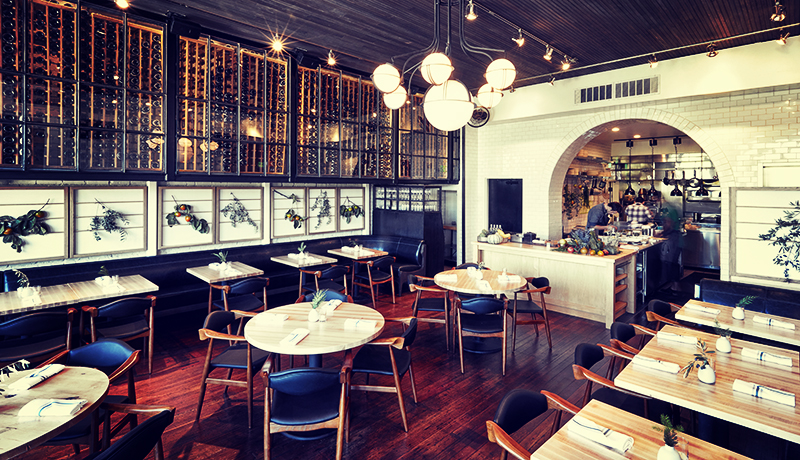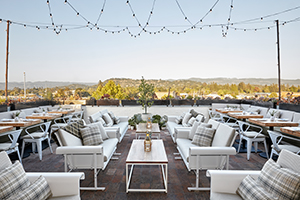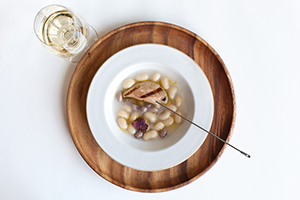

Dining Room
Photo Courtesy of Garrett Rowland
The Bay Area has long been considered a culinary epicenter; a sort of crossroads where wine, food, hospitality, farming and design come together to create many of the nation’s most interesting restaurants. The latest example of this culinary prowess is Ninebark in downtown Napa. From design-and-concept firm AvroKO and chef Matthew Lightner, Ninebark is a dining experience that is like no other. Located on restaurant-lined Main Street directly across from the Napa River, Ninebark is three restaurant concepts in one, each separated by floor. The first floor is a welcoming, relaxed and intimate bar with high tables and a menu of upscale bar snacks. The second floor is the meat and potatoes of the restaurant with an open kitchen, dining room and Lightner’s most complex menu. The third floor is a bustling bar, lounge and rooftop patio with a menu of hearty provisions and elegant plates.

Rooftop, Photo Courtesy of Garrett Rowland
One way to explain it is to think of the restaurant as a trio of siblings: with a playful, young, and slightly wild side, the first floor is the baby. The top floor is like the oldest sibling; it’s refined, on top of things and no pillow is out of place. The middle floor is the complex and creative middle child who is the grounding center of the family.
The division of concept by floor was a natural idea to the design team. AvroKO partner Greg Bradshaw says “the building is naturally a three-floor experience with very different environments on each floor.”
The bar on the ground floor is more casual and relaxed with an easy eats menu and no reservations required. The second floor is the chef’s finer dining spot with an open kitchen and an unfussy atmosphere. The third-floor lounge has some of the best views in Napa with an open roof deck and bar — ideal for swirling and sipping wine.
Chef Lightner says the three concepts have forced him to become more efficient. “It’s challenging because the building itself is large, but each floor is pretty small. You have to look at your efficiencies; every part of the building has to be useful.”
The three-in-one concept gives you a choose-your-own-adventure dining experience. An idea that Lightner enjoys: “It’s fun from a guest’s perspective! You come in, start on the roof and have cocktails and then move downstairs and have dinner on the second floor.”
When you arrive at the proper floor for your personalized culinary escapade, you can’t help but notice the beautiful and thoughtful design. AvroKO’s William Harris says the design feels like a kinetic, fantastical storehouse, with edible ingredients nearly everywhere — and he’s right. The walls of the first floor bar are filled with large jars of lavender, beans, chilies and preserved lemons. The light fixtures are stunning, there is warm wood everywhere, and a large arrangement of branches, leaves and wild flowers looks as if it has grown right out of the bar.
The walls on the second floor have persimmons hanging off of them, drying. “It’s a great way of using the aesthetic of the restaurant as extra storage,” explains Lightner of the changing edible decor.
There’s an organic feel to the space and you can tell that a lot of care went into the placement of everything, from the plaid blankets that dot the rooftop couches to the shiny arch of subway tile that frames the kitchen. Someone — perhaps one of the handsome bearded waiters — slides a delicate leaf or flower into each menu every day. That’s painstaking work, but the result is not fussy or pretentious, rather enveloping. You can’t help but appreciate the natural beauty and absurdity of it all.

Smoked Foie Gras with Beans and Fermented Truffle, Photo Courtesy of Kelsey McClellan
As for the food, Lightner describes his cuisine as seasonal but fun. “It’s familiar New American cuisine, but we make small little subtle takes on certain dishes. When we were strategizing we knew we wanted a wine-country-type restaurant, but we don’t want to do what everyone else is doing. We want to rethink provisions. We want it to be and do it all.”
And do it all he does. He makes luscious and flavorful spreads — whipped melt-in-your-mouth pork fat, mind-blowing carrot pimento dip, and rich spicy salame — and serves them with homemade crisps.
There’s a pickle plate that that can only be described as gorgeous, although pickles are not something one would normally think of as exquisite. However, Lightner’s pickles are like jewels. Tiny carrots, baby beets and whatever else may be fresh and delicious come served on a bed of ice, arranged just so with edible flowers as garnish.
Lightner has the ability to elevate many ingredients, not just pickles. He takes a traditional Spanish tapa, fried croquettes filled with salt cod, and turns it into a light and rich salt cod beignet.
A broccoli salad becomes luxuriously gourmet when Lightner chars and chops the broccoli then tosses it with smoked cheddar cheese (smoked in Ninebark’s smoker, of course), tangy green goddess dressing, and wild arugula foraged nearby. There’s also skewers of smoked foie gras, dumplings of chicken and shrimp, aged beef tartare with grilled lobster tail, and roasted pork neck with country gravy.
Lightner talks of the importance of connecting things in relation to food. “You want to connect to an ingredient’s natural flavor, so we try to figure out how we are going to make these bonds between nature, terrior, marine, plant and livestock.” While Lightner is focused on connecting to the ingredient, AvroKO’s Adam Farmerie highlights the natural connection between the chef and the design firm.
“His process in the creation of a menu is so similar to our design process it felt like shorthand collaborating,” Farmerie says. “While we talked a lot about approach in the early months, there was tremendous trust on both sides as we went into concrete development mode.”
This enlightened and quality of connection is transmitted to the diner. As you leave a meal at the restaurant, you can’t help but feel connected to the space, the chef, the food and the land. It’s as if Ninebark is an extension of Napa itself and that’s an experience that’s worth embracing wholeheartedly.
